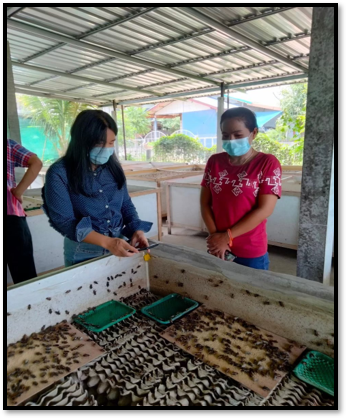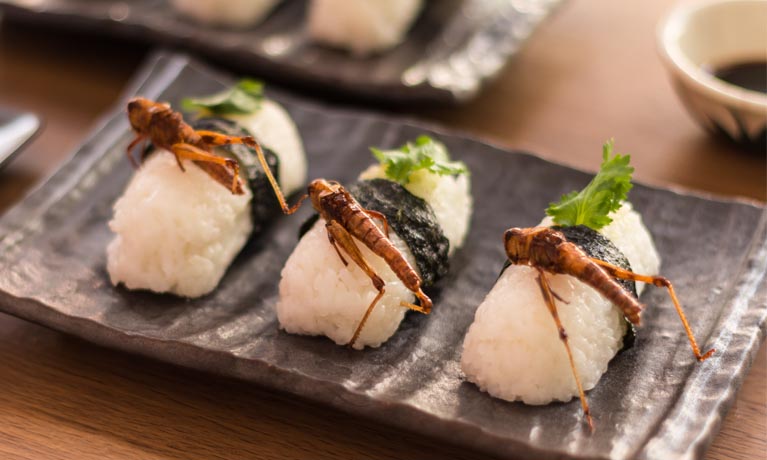By Dr Pattanapong Tiwasing, Dr David Bek and Dr Jennifer Ferreira
The COP26 climate summit in Glasgow is a meeting designed to explore the transformations needed to tackle the global climate emergency. One of the main goals of the meeting is to secure global net zero by mid-century in order to restrict increases in global temperatures to 1.5oC above pre-industrial levels. Given food systems account for around one third of all greenhouse emissions (Milman, 2021), it is vital to change patterns of food production and consumption in order to mitigate climate change risk (Xu et al., 2021).
Growing global demand for meat is resulting in very high greenhouse gas emissions, therefore a search for alternative proteins is of utmost importance. There has been much attention paid to the benefits of more plant-based diets, but another alternative is edible insects. The Food and Agricultural Organisation of the United Nations (FAO) has recognised the potential benefits of eating insects, known as entomophagy, as an alternative protein source, and made recommendations that they should become a greater part of diets in order to address issues of global food security (FAO, 2013, 2019).
There are over 2,000 species of insects that can be used for human consumption, either whole, such as dried crickets, or as an ingredient for a broader range of products, such as energy bars made with cricket flour. The species with the greatest potential for human consumption include beetles, mealworms, crickets, locusts, ants, moths and flies (Ordoñez-Araque and Egas-Montenegro, 2021).

The sustainable option
Compared to the production of meat, edible insects produce significantly less greenhouse gas emissions. Eat Grub, a UK-based company which specialises in edible insects, highlights that the average greenhouse gas production for 1kg of protein from insects is only 1g, compared to 2,850g for cattle, or 300g from chicken (Eat Grub, 2021). This is in addition to other environmental benefits related to insect production as insects do not require as much land to produce (they can be cultivated vertically) and require a lot less water and feed. Therefore, edible insect production can not only mitigate the negative impacts of climate change but also limit biodiversity loss.
The practice of eating insects is not new, particularly in developing countries, and various insects are an important part of many food cultures, from water bugs as a delicacy in Thailand to fried grasshoppers in Mexico. Over 2 billion people in over 140 countries consume insects as a regular part of their diet (Hanboonsong, Jamjanya and Durst, 2013). But in many western countries edible insects are still a novelty food, made (in)famous by popular TV programmes where they are used as part of eating challenges, rather than being recognised for their dietary and environmental benefits.
Regulatory barriers for novel foods
There are also barriers to expansion of edible insects becoming part of a mainstream diet. Regulation around the sale of insects for human consumption varies globally and can be unclear or even prohibitive. In the EU where regulations are still in development, they are considered a ‘novel food’ which means insects can be farmed and processed for human consumption, but only with specific authorisation which can be expensive, leading to a varied picture of how this has been put into practice. The UK, the Netherlands , Belgium, Denmark and Finland are home to various insect-based businesses which seek to increase the edible insect market, either through using insects in their products, or developing facilities to process them, although in the UK the legal situation has become unclear in the aftermath of Brexit, leading to uncertainty for many businesses in the sector (Boffey, 2020). Furthermore, food safety and hygiene practices need to be raised in producer nations such as Thailand if they wish to meet the food standards typically required in developed country markets.
The expanding global market
Then there are consumers. While eating insects may be commonplace in some regions, it is not a global phenomenon. Many western consumers are unfamiliar with eating insects, and may take some convincing to make them part of a daily diet (Motoki et al., 2020). However, shifts are starting to happen as more people are choosing to incorporate insects in their diets, especially in ground-up form. Furthermore, insects can be used as high protein feedstocks for animal and poultry production thereby reducing the environmental footprints of the meat and dairy sectors. Therefore, the global market for insects is expanding rapidly and significant export opportunities are opening up for producer nations who need to ensure that they are fully prepared to meet the import criteria of potential overseas markets.
Researchers at the Centre for Business in Society at Coventry University are exploring the potential of one country in particular, Thailand, the world’s largest producer of edible insects. Working with research teams in Mahasarakham University and Khon Kean University in Thailand the project is developing a roadmap to support development of Thailand’s edible insect industry to achieve export-readiness, and provide a sustainable protein alternative for more countries.

For more information about the project please visit: https://insectclub.weebly.com/
References
Boffey, D. (2020) Edible insects set to be approved by EU in ‘breakthrough moment’, the Guardian. Available at: http://www.theguardian.com/environment/2020/apr/03/insects-likely-approved-human-consumption-by-eu (Accessed: 20 May 2021).
Eat Grub (2021) Why eat insects and insect powders as a source of food? Eat Grub, Eat Grub. Available at: https://www.eatgrub.co.uk/why-eat-insects/ (Accessed: 18 October 2021).
FAO (2013) Edible insects: future prospects for food and feed security. Rome: Food and Agriculture Organization of the United Nations (FAO forestry paper, 171).
FAO (2019) Food systems at risk: New trends and challenges. Rome: FAO.
Hanboonsong, T., Jamjanya, T. and Durst, P. (2013) Six-legged livestock: edible insect farming, collection and marketing in Thailand. Bangkok: Regional Office for Asia and the Pacific of the Food and Agriculture Organization of the United Nations.
Milman, O. (2021) ‘Meat accounts for nearly 60% of all greenhouse gases from food production, study finds’, The Guardian, 13 September. Available at: https://www.theguardian.com/environment/2021/sep/13/meat-greenhouses-gases-food-production-study (Accessed: 18 October 2021).
Motoki, K. et al. (2020) ‘Contextual acceptance of insect-based foods’, Food Quality and Preference, 85. doi:https://doi.org/10.1016/j. foodqual.2020.103982.
Ordoñez-Araque, R. and Egas-Montenegro, E. (2021) ‘Edible insects: A food alternative for the sustainable development of the planet’, International Journal of Gastronomy and Food Science, 23, p. 100304. doi:10.1016/j.ijgfs.2021.100304.
Xu, X. et al. (2021) ‘Global greenhouse gas emissions from animal-based foods are twice those of plant-based foods’, Nature Food, 2(9), pp. 724–732. doi:10.1038/s43016-021-00358-x.




Comments are disabled